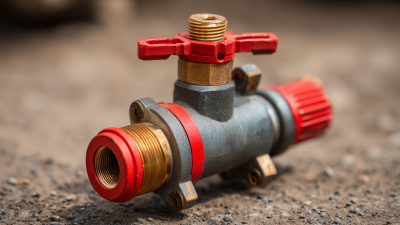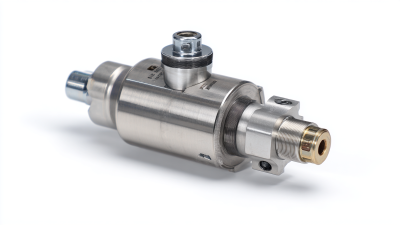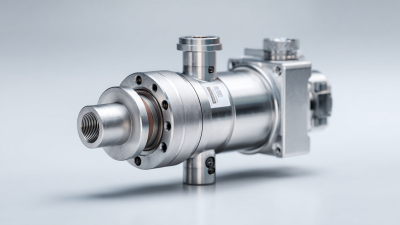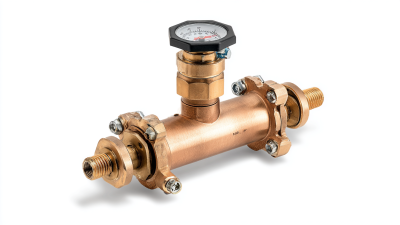- Products
- Pressure Reducing Regulators
- Back Pressure Regulators
- Tank Blanketing Valves
- Temperature Regulators
- Industrial Control Valves
- Wafer Style Control Valves
- JCVS Industrial Control Valves
- Globe Style/Cage Guided Control Valves
- Mixing/Diverting Control Valves
- Motor Operated Control Valves
- Valve Positioners & Accessories
- Applications
- Resources
- Find a Sales Rep
- Brands
7 Essential Tips for Choosing the Right Gate Valve for Global Procurement Needs
In the realm of global procurement, the selection of the appropriate gate valve is crucial for ensuring operational efficiency and reliability across various industries. According to a recent report by MarketsandMarkets, the global gate valve market is projected to reach $11.33 billion by 2026, growing at a CAGR of 5.2% from 2021. This growth reflects the increasing demand for reliable and high-performance valve solutions in oil and gas, water supply, and power generation sectors. Selecting the right gate valve not only impacts the functionality of systems but also influences maintenance costs and overall project timelines. With a myriad of options available, understanding the critical factors that define quality and suitability is essential for procurement professionals aiming to navigate this complex landscape effectively.

Understanding the Types of Gate Valves: A Comprehensive Overview for Global Procurement
When it comes to global procurement, selecting the right gate valve is crucial for ensuring efficient operations. Understanding the different types of gate valves available is the first step in making the right choice. There are primarily two types: wedge gate valves and parallel gate valves. Wedge gate valves are the most common, offering a strong seal and excellent flow control, while parallel gate valves are better suited for low-pressure applications where a tight shut-off is required.
Tip one for selecting the ideal gate valve is to assess the service conditions, including temperature, pressure, and media type. Each valve type has specific performance characteristics that cater to different operational requirements. Additionally, it's essential to consider the material of the valve—common materials include stainless steel, cast iron, and bronze—each offering unique benefits depending on the environmental and pressure conditions.
Another vital tip is to understand the valve's design features. Look for valves that provide easy maintenance and repair options, as this can save time and costs in the long run. Opt for models that offer features like blow-off ports or replaceable seats, which enhance longevity and reduce operational disruptions. By taking these factors into account, procurement professionals can secure the most suitable gate valves for their operational needs.
Key Specifications to Consider: Pressure Ratings, Size, and Materials for Gate Valves
 When selecting a gate valve for global procurement, it's crucial to focus on key specifications that directly affect performance and reliability. Pressure ratings are among the most important factors. Each valve has a maximum pressure they can withstand, and it is essential to match this with the system requirements to ensure safe operation. It’s advisable to consider valves with ratings that exceed the maximum expected pressure in your application to provide an added layer of safety and longevity.
When selecting a gate valve for global procurement, it's crucial to focus on key specifications that directly affect performance and reliability. Pressure ratings are among the most important factors. Each valve has a maximum pressure they can withstand, and it is essential to match this with the system requirements to ensure safe operation. It’s advisable to consider valves with ratings that exceed the maximum expected pressure in your application to provide an added layer of safety and longevity.
Size is another critical specification that should not be overlooked. Gate valves come in various sizes, and the right choice depends on the flow requirements of your system. A properly sized valve ensures optimal flow characteristics and prevents unnecessary pressure losses. Additionally, material selection plays a vital role in the performance of gate valves. Depending on the application—whether it's dealing with corrosive fluids or high-temperature steam—choosing the right material, such as stainless steel or carbon steel, can significantly impact valve longevity and maintenance costs. By paying careful attention to these key specifications, you can select the right gate valve that meets your global procurement needs effectively.
The Importance of Compliance: Navigating Industry Standards and Certifications in Valve Selection
When selecting gate valves for global procurement, understanding compliance with industry standards and certifications is paramount. Reports from the American National Standards Institute (ANSI) indicate that non-compliance can lead to costly delays and legal ramifications, underscoring the need for thorough vetting during valve selection. Familiarity with standards such as API 600 or ASTM can help procurement officers avoid pitfalls and ensure that the valves meet not just operational requirements but also regulatory benchmarks.
Tip 1: Prioritize suppliers with certifications from recognized bodies like ISO or API to ensure their products adhere to safety and quality benchmarks. This will mitigate risks associated with substandard materials and improve the reliability of your supplied valves.
Tip 2: Investigate the specific industry needs. For instance, the chemical processing industry often requires valves that comply with FDA regulations to prevent contamination, while the oil and gas sector might focus on anti-corrosion certifications to withstand harsh environments. By aligning your procurement strategy with these criteria, you will enhance operational efficiency and safety.
Engaging with compliance experts and utilizing resources like the International Organization for Standardization (ISO) database can further streamline the selection process. Ultimately, this diligence not only saves time and costs but also fosters a commitment to quality that resonates across the supply chain.
7 Essential Tips for Choosing the Right Gate Valve for Global Procurement Needs
| Selection Criteria | Importance | Industry Standards | Certifications |
|---|---|---|---|
| Material Compatibility | Ensures longevity and prevents corrosion | ASTM, ASME | ISO 9001 |
| Pressure Rating | Critical for safety and performance | ANSI | CE Marking |
| Size and Dimensions | Facilitates correct installation | DIN | API 6D |
| End Connection Type | Ensures compatibility with existing systems | JIS | TUV |
| Temperature Range | Affects performance and safety | ISO 14313 | UL Certification |
| Actuation Method | Influences ease of use | API 598 | FM Approval |
| Cost and Budget | Impacts overall project feasibility | N/A | N/A |
Evaluating Supplier Reliability: Best Practices for Sourcing Gate Valves Globally
When sourcing gate valves globally, evaluating supplier reliability is paramount. According to the latest IDC report on the server market, collaborations and partnerships are crucial for sustaining growth in the supply chain sector. This insight signifies that working with reputable suppliers can enhance procurement strategies significantly. Suppliers known for their stability can provide the assurance that quality gate valves will be consistently available, thus preventing potential disruptions in your operations.

Additionally, it is vital to examine a supplier's track record in the industry. The shift towards technology-driven solutions in procurement, highlighted by recent developments in AI and supply chain management, indicates that firms like Intas Pharmaceuticals have successfully navigated post-pandemic challenges by integrating advanced technologies. A supplier that harnesses these innovations is likely poised to deliver products efficiently and manage risks effectively. Avoiding supply chain bottlenecks ultimately hinges on selecting partners who not only demonstrate product excellence but also embrace modern advancements to enhance reliability and performance.
Cost vs. Quality: Analyzing the Economic Impact of Gate Valve Choices in Procurement Decisions
When selecting the right gate valve for global procurement, the balance between cost and quality is paramount. In procurement decisions, choosing a gate valve solely based on price can prove detrimental in the long run. A recent analysis highlighted that while low-priced valves might minimize initial expenditure, their failure rates often lead to higher total costs of ownership (TCO) due to additional maintenance and replacement needs. For example, a comprehensive study revealed that high-quality gate valves can reduce failure rates by up to 30%, subsequently lowering repair costs and downtime.
Furthermore, the application of methodologies like Quality Function Deployment (QFD) in the procurement process can enhance decision-making by aligning product features with customer expectations. A case study indicated that organizations employing Analytical Hierarchy Process (AHP) alongside TCO assessments achieved decisions that not only accounted for upfront costs but also integrated long-term performance and sustainability considerations. This indicates a clear trend towards valuing quality in procurement, ultimately leading to more sustainable practices in design and construction. As the industry continues to evolve, prioritizing quality gate valves becomes an essential strategy for ensuring operational efficiency and sustainability in procurement decisions.
Cost vs. Quality in Gate Valve Procurement
Related Posts
-

Mastering High Pressure Regulation: A Step-by-Step Guide to Choosing the Best Regulator
-

Unlocking Performance: Key Technical Specifications of the Best Back Pressure Valve for Global Buyers
-

Future Trends in Best Flow Valve Market Analysis for 2025 Industry Outlook
-

Emerging Trends in Back Pressure Valve Technology by 2025 and Their Key Advantages for Global Buyers
-

5 Essential Tips for Choosing Your Water Pressure Regulator Valve
-

Exploring Unique Examples of Pressure Valve Applications in Industrial Processes
